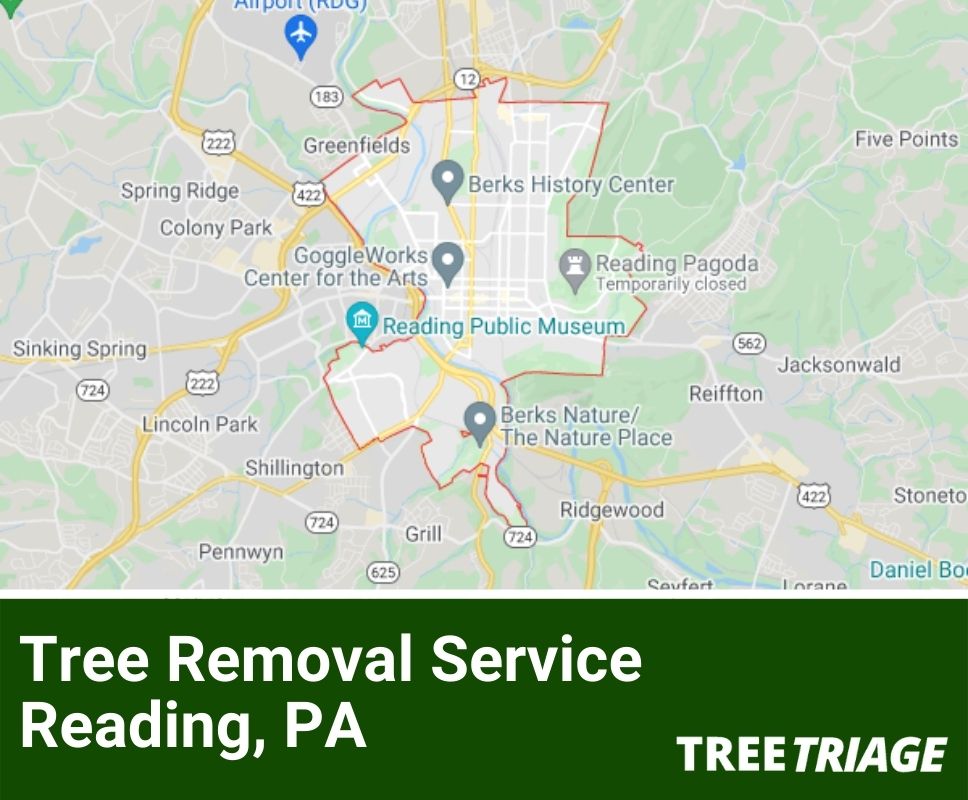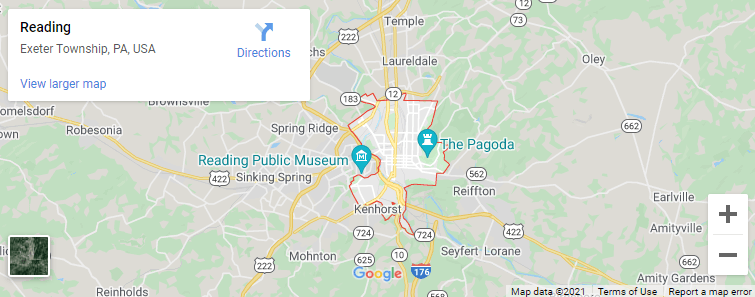Contents (Click To Jump)
- 1 What Are the Most Common Tree Issues in Reading?
- 2 Does the City of Reading Provide Any Assistance in Tree Removal Problems?
- 3 Who Is Responsible for Fallen Tree Removal in Reading?
- 4 How Does the Soil Affect Trees in Reading?
- 5 Does Weather Affect Tree Health in Reading?
- 6 What If Dead Trees Are Near Power Lines in Reading?
- 7 How Much Does Tree Removal Usually Cost in Reading?
What Are the Most Common Tree Issues in Reading?
Nestled against the backdrop of the picturesque Nolde Forest, Reading is home to an array of indigenous tree species including the Japanese zelkova, sugar maple, black ash, eastern hemlock, hawthorns, and silver leaf linden. Our research shows that Reading’s forests, which were overexploited during the industrial revolution, are now making a comeback thanks to the spirited conservation efforts by the city’s authorities. These efforts saw the city win the coveted 2013 Tree City USA award, recognizing the community’s commitment to tree conservation.
While Reading has an impressive tree cover, we found out that some tree diseases reduce the lifespan of residential and urban trees. We dug deeper and found the following issues affecting Reading’s trees:
Oak Wilt
One of the most dreadful tree diseases is oak wilt. Some Reading residents called us after noticing symptoms such as rapid discoloration and premature defoliation. If you have oak trees, the veins will likely turn yellow then brown in a few days before defoliation occurs. Infected beetles are the disease carriers through root grafts. Homeowners with oak trees, especially those in the red oak group, should look out for these symptoms in their oak trees to prevent them from dying.
Anthracnose
Deciduous trees in Reading such as ash, maple, dogwood, and sycamore are the most affected by anthracnose. If you notice some browning color along leaf veins, small dead spots on leaves dying buds, or premature defoliation, it may be anthracnose because it’s a stem and leaf disease. The disease attacks these trees at the start of the season and you can easily confuse it with frost damage.
Powdery Mildew
As the name suggests, this tree disease can be identified by the powdery white substance on the leaf surface. The substance is due to tiny fungal spores which lead to a decline in the tree’s growth rates. You will see the tree leaves turning brown or yellow, and it can even lead to premature dropping after some time. We noted that heavily shaded young trees are the most impacted.
Lanternfly
The lanternfly pest is another threat to trees in Reading. Since 2014, we have identified these insects invading trees in this city. The insects feed on the trees, which affects the local ecosystem and business owners like orchards and vineyard growers. The pests pose a great threat not only in Reading but also in greater Pennsylvania. The infestation led to an initiative by Penn State University, the Department of Agriculture in Pennsylvania, and the agricultural department in the US. A group of 150 experts and researchers were given the responsibility to work on the best strategies to fight the insects in the coming years.
Luckily, research by Cornell University found that two fungal pathogens that could eliminate the lanternfly are Beauveria bassiana and Batkoa major. Even better, the pathogen exists within Berks County and they had already killed sizeable swaths of lanternflies towards the end of 2017. The official report in the study indicated that about 97% of the lanternflies had been killed on tree trunks.
Naturally Occurring Events
While we may have the solutions to fight pests and tree diseases, we can’t fight against naturally occurring events. Even with accurate weather predictions, we can only hope that the trees will survive.
In Reading, strong winds and unusual weather are common, and tender trees are mostly affected. We have witnessed various cases of straight-line winds that have toppled trees and knocked down power lines in the city. Reading residents also have to deal with ripped roofs due to the fierce winds. According to the National Weather Service chief meteorologist, the winds are not new in this area and they cause about 98% of damages. The winds were once so strong that they brought down one of the largest trees in Delaney Circle in West Reading. Thunderstorms are also common in Reading and they have their fair share of tree destructions. One notable scenario happened in 2004 that ravaged multiple trees on Monocacy Hill.
Does the City of Reading Provide Any Assistance in Tree Removal Problems?
Reading considers tree cutting as a major landscaping project and residents should always hire our licensed arborists. However, if you need some small tree trimming services, the city can assist at your request. Make sure the piles of tree debris don’t exceed three feet wide by four feet long.
Who Is Responsible for Fallen Tree Removal in Reading?
Depending on the location of a fallen tree, it may be the property owner’s responsibility or the city’s to remove the tree. As per the city’s codes, the Department of Public Works has the right to protect and remove trees along streets and highways. Other scenarios that you may need to keep in mind include:
If You’re a Homeowner?
As a Reading resident, you are allowed to remove trees whenever you wish, provided the tree is within your property. Make sure you involve our certified specialists in the city.
If You’re a Renter?
When a tree falls within your rented space, call the property owner immediately to arrange the tree removal procedures. In most lease agreements, you don’t have the responsibility to remove or trim the trees.
If You’re a Landlord?
As a landlord, you are still considered the owner of the trees on your property. Therefore, when a tree falls, call us to get rid of it.
If You’re a Neighbor?
When a neighbor’s tree or branches fall into your property, it’s their responsibility to remove the tree. In fact, diseased or damaged trees are a potential hazard to a neighbor or a public space, and failure to remove them leads to a penalty according to section 555-114.
How Does the Soil Affect Trees in Reading?
Generally, Reading’s soils are fertile and productive for agricultural production. The areas with limestone soils are particularly more fertile and usually provide optimal conditions for tree growth. However, some areas also contain acidic soils and require fertilization to maintain tree health.
Does Weather Affect Tree Health in Reading?
There has been a continuous trend of changing climatic conditions in Reading, which threatens some of the plants. Some of the tree species that we are used to, such as paper birch, mountain maple, and American beech, are not adaptive to these changing weather conditions. As a result, some of the most vibrant summer, fall, and spring scenes may slowly end due to climate change. These climatic changes impact the trees since they cannot adapt, and the increasing stress will lead to more trees dying. The authorities have started working on some strategies for better forest management, including shifting to change resilient trees. To protect the trees, the agency focuses not only on state forests but also privately owned ones.
Still, not only is Reading experiencing rising temperatures, but also more frequent storms. Research by the Northern Institute of Applied Climate Science, temperatures had already started rising by up to 1.8 degrees Fahrenheit in the early 20th century. Between 1970 and 2000, winter temperatures have risen fast, increasing 1.3 degrees Fahrenheit every decade. As a result, we have experienced heavy storms, higher annual precipitation, and very hot days. In 2018, most places in Pennsylvania set a record for the highest rainy days and annual rainfall in total.
Due to the continuous warming trends, the native tree species may not survive, such as the American mountain ash. Homeowners should opt for climate-resilient trees such as box elder, hackberry, eastern redbud, and sycamore. Additionally, the weather changes will impact the entire ecosystem, and you may see an increase in invasive pests.
What If Dead Trees Are Near Power Lines in Reading?
Dead trees cause power outages in Reading, especially during heavy storms. Consequently, the law restricts Reading residents from planting tall trees close to or under power lines. The city’s power company regularly checks on any trees growing too close to the power lines. If there are trees near power lines, the company sends their contractor to trim, prune, or cut the tree.
How Much Does Tree Removal Usually Cost in Reading?
If you plan to cut a tree in your yard, you should know the costs of the entire project. Even if it’s just a simple tree pruning or trimming, you will still pay for the services. Besides, many tree species in Reading require high maintenance levels. The basic pruning and trimming will cost you an average of $350, while for an entire tree removal project, most homeowners in Reading pay an average of $700.
Still, the prices can be a minimum of $210 or a maximum of up to around $1,800. The costs vary depending on various factors specific to your project. In some cases, if you live in areas with a higher cost of living, you might pay the higher end of the price range. The common factors determining the costs include the following:
Height of the Tree
The tree’s height is a significant determinant of the total amount for cutting a tree in Reading. A shorter tree is easier for us to trim or cut and takes relatively less time for the entire project. However, tall trees such as tulip – which are considered the tallest in Reading – present more challenges and may need extra equipment, which is an added cost. We can break down some tree removal prices based on different height as follows:
- 20-foot tree – $210 to $380
- 40-foot tree – $400 to $700
- 60-foot tree – $590 to $1100
- 80-foot tree – $800 to $1450 or more
Condition of the Tree
A tree that is in a poor or fragile state requires more caution during the removal process. Our arborist will also have to evaluate the tree before cutting it. You will have to pay more for the assessment, and it will take more time to cut the tree, which translates to more expenses.
Location and Accessibility of the Tree
You may have a difficult yard to access, or the tree is too close to your property. As a result, it will take more time for us to cut the tree due to poor access while also preventing property damages. We may also even decide to trim some branches before cutting down the entire tree, which adds more costs.






